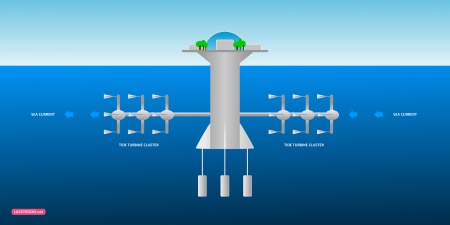Difference between revisions of "Currents"
Thebastidge (talk | contribs) |
|||
| (5 intermediate revisions by 3 users not shown) | |||
| Line 1: | Line 1: | ||
| + | ==Description== | ||
| + | |||
| + | (From Section 5 of [https://ww2.eagle.org/content/dam/eagle/rules-and-guides/archives/offshore/104_sfaforfloatingoffshorestructures/pub104_offshoresfa_guide.pdf ABS GUIDANCE NOTES ON SPECTRAL-BASED FATIGUE ANALYSIS FOR FLOATING OFFSHORE STRUCTURES . 2005] | ||
| + | |||
| + | Current in the ocean can be any or any combination of wind-driven, thermo-haline, tidal and storm surge currents. At a location (installation site), the current is defined by its speed and directional profiles through the water depth. Currents may change with time, from hourly to seasonally. Although current itself can be treated as producing essentially static loads, it can induce or intensify certain kinds of dynamic loads and fatigue damage (especially for slender structures such as mooring lines and risers). There are mainly two ways current can affect fatigue: | ||
| + | |||
| + | 1) the presence of a current can increase cyclic drag loading of waves due to the nonlinear coupling of current velocity and wave orbital velocity. It is recommended that current be considered if its magnitude is comparable with the wave orbital velocity for those waves that make the greatest contributions to the fatigue damage; | ||
| + | 2) Current may also create cyclic “lifting” loads due to vortex shedding, which can cause significant fatigue damage. | ||
| + | |||
| + | |||
==Currents as a hazard== | ==Currents as a hazard== | ||
| − | + | *[https://dspace.lboro.ac.uk/dspace-jspui/bitstream/2134/6649/1/Passmore%203.pdf Drag levels and energy requirements on a SCUBA diver] | |
| + | *[http://www.mindspring.com/~divegeek/rivertech.htm River Diving Technique] | ||
| + | |||
| + | ==Engineering for== | ||
| + | *[[Current Loads]] | ||
==Using currents for energy== | ==Using currents for energy== | ||
* [http://news.nationalgeographic.com/news/2008/05/080501-wave-video-ap.html Undersea "Wind Farms" Tested (video)] National Geographic | * [http://news.nationalgeographic.com/news/2008/05/080501-wave-video-ap.html Undersea "Wind Farms" Tested (video)] National Geographic | ||
[[Image:Seasteading_tidepower.jpg|450px]] | [[Image:Seasteading_tidepower.jpg|450px]] | ||
| + | |||
| + | {{Ocean Environment}} | ||
| + | {{Energy}} | ||
Latest revision as of 18:28, 2 August 2017
Description
(From Section 5 of ABS GUIDANCE NOTES ON SPECTRAL-BASED FATIGUE ANALYSIS FOR FLOATING OFFSHORE STRUCTURES . 2005
Current in the ocean can be any or any combination of wind-driven, thermo-haline, tidal and storm surge currents. At a location (installation site), the current is defined by its speed and directional profiles through the water depth. Currents may change with time, from hourly to seasonally. Although current itself can be treated as producing essentially static loads, it can induce or intensify certain kinds of dynamic loads and fatigue damage (especially for slender structures such as mooring lines and risers). There are mainly two ways current can affect fatigue:
1) the presence of a current can increase cyclic drag loading of waves due to the nonlinear coupling of current velocity and wave orbital velocity. It is recommended that current be considered if its magnitude is comparable with the wave orbital velocity for those waves that make the greatest contributions to the fatigue damage; 2) Current may also create cyclic “lifting” loads due to vortex shedding, which can cause significant fatigue damage.
Currents as a hazard
Engineering for
Using currents for energy
- Undersea "Wind Farms" Tested (video) National Geographic
| Ocean Environment |
|---|
| General · Waves · Sea state · Currents · Wind · Politics · Piracy · Biofouling |
| Energy |
|---|
| Hydrothermal · OTEC · Wave Power · Currents · Osmotic Power · Energy Storage · Micro-grid · Biofuel · Wind turbines · Kites · Photovoltaics · Nuclear |
